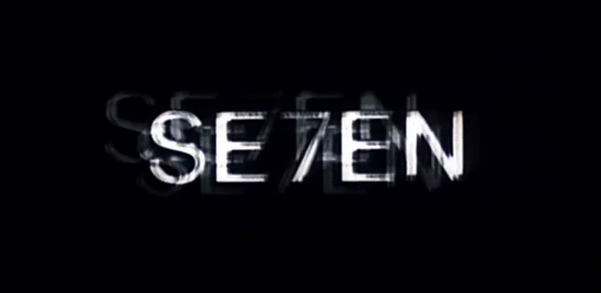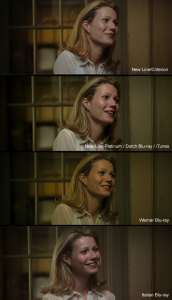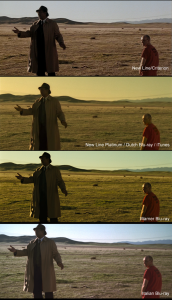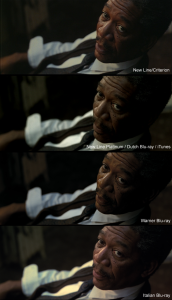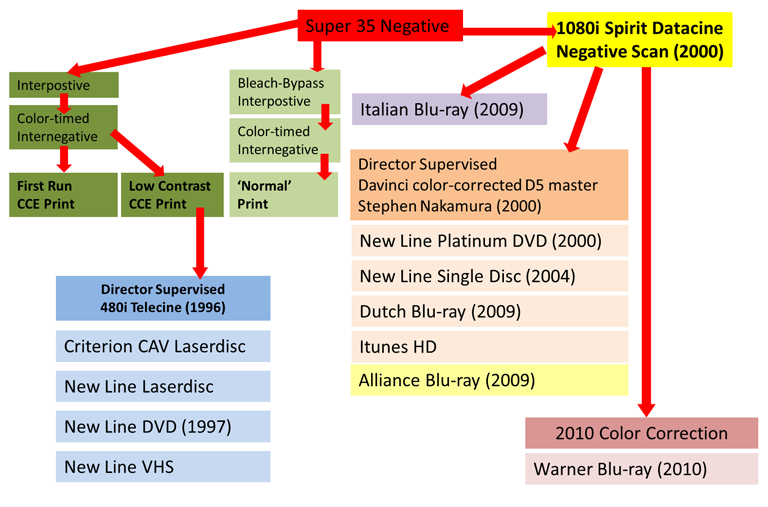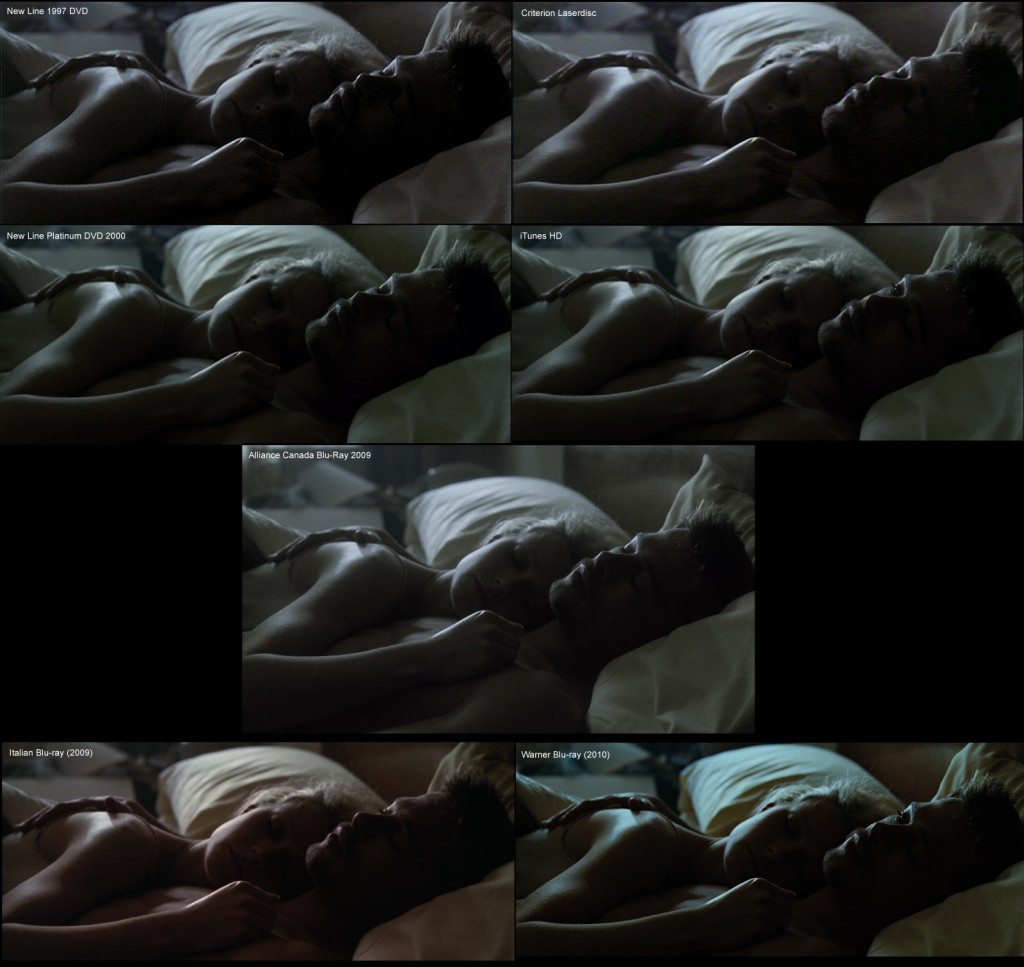Se7en is a dark crime-horror fantasy, written by Andrew Kevin Walker, directed by David Fincher with cinematography by Darius Khondji. The film was a success both commercially and critically. However due to the complexity of the photographic process, it is difficult to be certain that any of the home-video releases reflect the image seen in first run showings. This article will examine the various video releases of Se7en, and explain the process by which they came about, and attempt to pick the best amongst them.
Se7en Through The Lens
During production careful consideration was put into developing the film’s ‘look’ by both the art department and the Cinematographer.
- Super 35 cameras were used, which allowed the use of faster and wider ‘spherical’ lenses with shallower depth of field than comparable anamorphic lenses
- The use of Super 35 also allowed some flexibility in re-framing shots in post production, since the film was intended to be projected in a 2.40:1 aspect ratio
- On set smoke was used to reduce contrast and provide atmosphere to scenes
- For some scenes the negative was ‘flashed’ using a Panaflasher to further reduce contrast, and bring out shadow detail
- The film was pushed one stop (under-exposed and over-developed) to increase density and saturation
- A Deluxe ‘Color Contrast Enhancement’ or ‘CCE’ bleach-bypass process was used for first run prints, increasing contrast, effectively crushing blacks
- The CCE process was deemed too expensive for the majority of first and second-run prints, which were then struck from an inter-positive that had itself been bleach-bypassed, which approximated the effect of the CCE process. This meant that there would be differences between the first-run showings of the film, and subsequent runs
Se7en Home Video Releases
Criterion/New Line Transfer (1996)
When it came time to release the film on home video, David Fincher chose to re-create the look of the CCE process. A low-contrast print was created to be telecine’d, and the movie was re-graded by David Fincher scene by scene, and a 480i master was produced. This master was shared by the New Line releases (AC-3 Laserdisc, DTS Laserdisc, VHS, ‘flipper’ DVD) and a Criterion Collection CAV Laserdisc set which included a number of (then) exclusive special features. Various other sources claim that the Criterion transfer is different, upon inspection, this is not the case.
This transfer features excellent color, and deep, dark blacks that look totally appropriate for a late 1990s film. However, it does have some problems: The film was scanned at 480i, and at some point was put on a composite master tape, and as a result it has composite video noise.
The DVD is a very early effort, and contains half the film on one side, and half on the other. This allows a higher bitrate, which given the poor quality of early MPEG-2 codecs, is probably a blessing. Using both sides of the disc allows 6.7 gigabytes to be given to the feature, with a healthy 7 to 8 megabit bitrate most of the time. Despite the bit-rate, the quality of the disc appears to be limited by that of the master source.
The DVD version also features a vertical white line which runs the entire duration of the feature down the left hand side of the frame. It does not appear to be a negative scratch and is so far to the side of the image that it would have certainly been in the overscan area of any normally adjusted CRT television. Also the picture edge often falls shorts of both the white line and the absolute right and left edge of the frame depending on the shot.
The Criterion laserdisc doesn’t have the white line, but instead doesn’t reach that far to the left or right (at least on my displays). Quality is about par for a CAV laserdisc, but it doesn’t hold a candle to the DVD.
Of this first batch of releases, I would recommend the DVD. Despite being a flipper, and non-anamorphic – the picture quality far exceeds that of the Laserdisc transfers.
Se7en New Line Platinum Edition (2000 Remaster)
After finishing work on ‘Fight Club’ in 2000, Fincher returned to Se7en to do a fresh anamorphic DVD transfer. Once again, he wanted to work from a freshly struck print, however he found it impossible to get sufficient density in the print blaming changing lab practices. So he opted to have the negative scanned directly, and perform color-correction in the digital domain to restore the bleach bypass look.
A 1080i scan was made using a Spirit telecine machine, and recorded to D5 digital HD videotape. I believe this negative scan is the source for all subsequent home video releases. Fincher worked with colorist Stephen Nakamura, who had done timing work on video dallies during production of Se7en.
The New Line Platinum Edition DVD was released in 2000, and was positively reviewed, and included much of the supplemental material that was included in the Criterion Laserdisc set.
Overall the transfer is a little more ‘pushed’ looking than the earlier transfer, with a green tint throughout. It doesn’t look bad, but starts to look more like a 2000 film, with the use of Davinci ‘power windows’ allow manipulation of the image that wouldn’t have been possible. Secondary color corrections to the climax are apparent.
A film only DVD edition of the transfer was released 2004.
The Dutch Blu-ray released in 2009 appears to have used this transfer, as does the iTunes HD version.
New Line Goes Under
Despite a run of successful movies including the massively profitable Lord of the Rings trilogy, New Line hit a problem adapting children’s fantasy epic: ‘The Golden Compass’. The movie’s budget had ballooned up to 180 million dollars, to partially fund this, New Line had sold the overseas rights upfront. The film was released to positive reviews, but didn’t make much impact at the US box office, pulling in a gross of only 25 million dollars. Overseas the movie fared better, but since none of the overseas profits made their way back to New Line, they were now looking at a huge loss. Warner Brothers stepped in and merged with the studio.
This merger meant that the home-video rights for many of the features, including Se7en, fell under Warner.
HD Editions (2009 to present)
The following is largely speculation:
A large number of New Line titles have been released in Canada by Alliance (and vice versa), this leads me to believe that there was a standard licensing deal in place between the two. Licensing deals of this nature would typically be time bounded (say 10 years), and would include clauses such that the licensor would be obliged to provide the ‘best’ master materials reasonable available. After spending considerable money on New Line, Warner would have looked at the catalogue to determine how it could start monetizing it. Since Alliance licensed Se7en sometime in 2000 to release the Canadian version of the New Line Platinum edition, it seems probable that this license was due to expire in 2010.
Alliance wanting one last bite of the cherry decided to release Se7en on Blu-ray in 2009, and asked Warner for a HD transfer of Se7en. Warner recognized that providing them with a good HD 1080p copy of the director supervised 2000 transfer would diminish the value of the property when they came to renegotiate in 2010; so Warner provided them with the ‘Best’ transfer available, a copy of the unmatted, 1080i version. Alliance simply shrugged and released it.
As previously noted, the iTunes version and the Dutch Blu-ray also use the 2000 master, but are matted.
Another, possibly related transfer was used for the Italian 2009 Blu-ray, however this is appropriately matted, and appears to have very little in the way of color-correction applied. Looking at the bonus materials from the 2000 DVD, which include a demonstration of the Davinci color corrector in action, the Italian Blu-ray looks pretty close to the uncorrected master they are working from. Interestingly the Italian inter-titles appear to have been upscaled from an earlier DVD master.
Se7en Warner Blu-ray (2010)
Reading between the lines it appears that the most recent Blu-ray edition is the 2000 Datacine transfer with a new modern look color-correction. I’m not clear who was involved in the transfer, and if it was director approved or not.
I’m going to say this simply: It looks good, but it doesn’t look like a 1995 movie. Very strong secondary color corrections are pretty obviously applied, and the color begins to shift towards Orange and Teal. A lack of grain also implies the use of DVNR, though it’s hard to catch-it out.
| Release | Year | Transfer |
|---|---|---|
| Selected first-run prints | 1995 | CCE bleach-bypass transfer |
| Most first-run and second-run prints | 1995 | Regular print from bleach-bypass inter-positive |
| Criterion CAV Laserdisc | 1996 | From a special low-contrast CCE print with some tweaks. Particularly noticeable in the ending sequence. |
| New Line Laserdisc, DTS Laserdisc, DVD and VHS | 1996 | Same as Criterion. Non-anamorphic widescreen. for the DVD. |
| New Line Platinum DVD / New Line Single Disc | 2000 / 2004 | Recreated CCE look from original negative on a 1080i Spirit Datacine scan. Anamorphic DVD. |
| Dutch Blu-ray | 2009 | Same transfer as 2000 DVD, but in 1080p |
| Alliance Canadian | 2009 | Seems to be an unmatted version of the 2000 remaster. Has the incorrect aspect ratio of 1.78:1. |
| New Line/Warner Blu-ray | 2010 | Fresh color correction. I suspect sourced from the 2000 Spirit Datacine scan. DVNR and aggressive color-correction. |
| Italian Blu-ray | 2009 | Interestingly different from all the other transfers. Some sweetening, but possibly an uncorrected version of the 2000 Spirit Datacine scan. Nicely grainy. |
| iTunes 1080p | 2004 ? | Same transfer as the 2009 Alliance Blu-ray, but at correct Aspect Ratio. |
A Se7en Family Tree
Conclusions
So which version should you watch ? Well, that depends. In my opinion the two best options are either the 1997 New Line DVD, or the Dutch Blu-ray. Why ?
The 1997 New Line DVD is the best way to see something like a CCE print, which is how it would have looked in the Cinema in 1995. It also features the original, a mostly un-tampered-with cinema soundtrack.
The Dutch Blu-ray is the best way to see the 2000 transfer, second best choice would be the iTunes HD version. While the 2000 transfer has been messed around with in the digital domain, it was done by the supervised by the Director relatively recently after the film was completed, and the colorist was involved in the original production.
Se7en Transfers Compared
Notes
My two Laserdisc players died while writing this article! My main NTSC player, a fancy CLD-99 clone, developed terminal belt problems that prevent it spinning up, and my backup PAL/NTSC player died during a side change. In the words of John Doe: ‘That wasn’t me’ !
Interviews
- Interview: http://www.dvdtalk.com/interviews/david_fincher_s.html
- Interview: http://www.dvdreview.com/html/dvd_review_-_david_fincher.shtml
- Interview: http://www.micasamm.com/articles/widescreen_0201.html
Se7en Reviewed
- New line laserdisc: http://www.widescreenreview.com/ld_detail.php?recid=1855
- New line DTS laserdisc: http://www.widescreenreview.com/ld_detail.php?recid=2482
- Criterion laserdisc: http://www.widescreenreview.com/ld_detail.php?recid=1856
- New line DVD: http://www.widescreenreview.com/dvd_detail.php?recid=174
- New Line Platinum DVD: http://www.widescreenreview.com/dvd_detail.php?recid=1671
- Dutch Blu-ray: http://www.ohmb.net/showthread.php?t=18186
- Aliance Canada Blu-ray: http://www.dvdbeaver.com/film2/DVDReviews44/se7en_blu-ray.htm
- New Line Blu-ray: http://www.dvdbeaver.com/film2/DVDReviews44/se7en_blu-ray.htm
FTC Disclosure: I am an iTunes and Amazon affiliate advertiser, this means that if you click on one of the links above, I get a very small amount of money.

